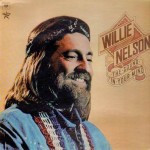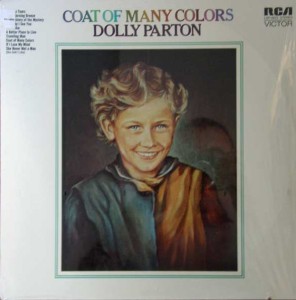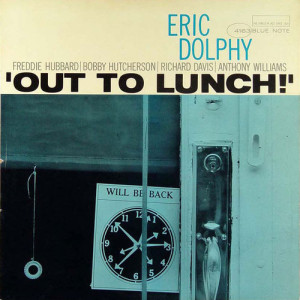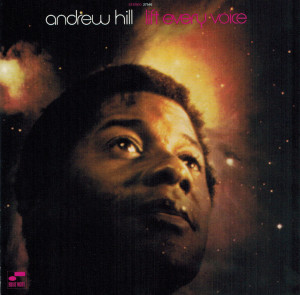Link to an article by Pavlina Tcherneva:
Month: April 2015
Dolly Parton – Coat of Many Colors
Dolly Parton – Coat of Many Colors RCA Victor LSP 4603 (1971)
Dolly’s big breakthrough as a solo act was Coat of Many Colors, with the opening three songs each becoming hits. However, the album as a whole, while often regarded as finding her at an artistic peak, is deeply contradicted. Her former duet partner Porter Wagoner wrote three of the songs, and they are largely the worst things here, from the creepy swingers song “If I Lose My Mind” to the drab religious tune “The Mystery of the Mystery” they have no heart and simply scrape around for anything that will appeal to a target demographic. The big surprise, though, is Dolly’s songwriting. “My Blue Tears” and “Here I Am” are pretty compelling, with clear lineage to Nashville country music of old but also warm, modern electric instrumentation that slides gracefully into the then-burgeoning singer-songwriter movement on the U.S. West Coast. There aren’t any great surprises in the performances, but they all easily make use of the best contemporary trends with an open mind.
With the title track, it is worth contrasting Dolly to another big country star of the day: Loretta Lynn. Lynn was a bold songwriter, who had a hit in 1970 with “Coal Miner’s Daughter,” an autobiographical song about growing up in Butcher Hollow, Kentucky. Dolly’s song is about compensating for the shame and deprivation of poverty with family ties, while Lynn’s is more about the dignity of subsistence labor. The perspective in Dolly’s song is of a clash of different value systems, one based on monetary wealth (that would buy a new, professionally made coat) and self-improvised utility (making a coat from rags, for lack of alternatives). But while she sings about not understanding why others don’t recognize the “love” that went into making the homemade “coat of many colors,” there is a conceit in pleading for the listener to place what she had above what she lacked, by tacitly accepting the value system of the kids who laughed at the poverty her homemade clothing symbolized. She sings, “One is only poor only if you choose to be,” the classic trope that everything in the world is purely a matter of individual choice rather than choice positioned in a context of constraints that might not be subject to an individual’s control. Lynn’s song envisions something beyond a value system that denigrates the work of a Kentucky coal miner to support a family, and grapples with the concrete ways her family addressed the hardships of poverty. “Coal Miner’s Daughter” looks back on the past, and finds meaning (truth) in what survived (in memories) and lead to where she ended up. “Coat of Many Colors” likewise looks back on the past, but as a sentimental episode confined to the past. Its only relationship to the present seems to that of a distancing effect, by placing deprivation in a bygone era that was somehow overcome (in ways never explained or implied by the song). To put it more simply, Dolly’s song competes within a system that strives to place winners above losers and claims a victory in that terrain, while Lynn’s song calmly rebels against such a system by entertaining the possibility of every humble person living a good life on her own terms without distinguishing between winners and losers. So, even from just the microcosm of these two songs, it is no surprise that Lynn’s persona was that of a feminist icon, with a sassy, “independent woman” demeanor that was at odds with the normally conservative politics behind commercial Nashville music of the day, while Dolly’s was that of a woman succeeding within the confines of a social structure that assigned her to a subordinate status by playing the “Backwoods Barbie Doll” role. Dolly later starred in Hollywood movies, at most in roles in which her character seeks accommodation and satisfaction in unjust scenarios, while a “New Hollywood” movie based on Lynn’s life boldly had non-musician actresses sing — convincingly — songs associated with talented country stars.
Eric Dolphy – ‘Out to Lunch!’
Eric Dolphy – ‘Out to Lunch!’ Blue Note BLP 4163 (1964)
For a long time, my favorite album. I know it so well. These days, I rarely ever listen to it. I carry it with me, in my head, always. So, little need for stereos. Except, the vibrations are good. So every once and a while, I take the time to play it, just to feel it.
It is hard to find words to describe this album. One can only claim to shed some light on its context. Sometimes hailed the greatest jazz recording of the 20th Century, it is certainly a key step through any legitimate jazz listening education.
Eric Dolphy was a star amidst the early “free jazz” movement of the sixties, if there was such title to bestow. He played with most of the key players at one point or another (even La Monte Young in junior high!). A California symphony denied him a seat, likely based on his race. His friend Richard Davis describes Dolphy as “an angel” and said if you heard something from Eric, it was true. His music reflected his personality. It was always reaching, but peaceful and wise.
This music arrives independently at chordal improvisation. It’s not that it begins with a structure. Rather, Dolphy rethinks his entire musical universe and then constructs his own version of what it could be. The result just happens — by chance — to sound like it employs traditional values. New concepts emerge. As much as it touches on traditional values the previous standards fail to address the full scope of this album. The textures and melodic/harmonic interplay create something beyond the music, beyond its context, leading the listener into some shining palace where each moment lingers infinitely as it unfolds its wisdom. The entire point is that it’s not quantifiable. Dolphy seems to say that music should break down limitations. The destination would be unreachable by limited, traditional means (like you can’t get through the gates dragging a set of preconceived notions). All too often there is a disbelief that this album reaches the level it does.
Dolphy’s solos used dramatic intervals and a host of quite unique sounds: honking, buzzing, and anything else that suited the music. A remarkable improviser, Dolphy could give anyone a run for their money (like John Coltrane during their 1961 stand at the Village Vanguard). He was an accomplished multi-instrumentalist. ‘Out to Lunch!’ displays his three primary tools: the bass clarinet, alto saxophone, and flute. His style was remarkably vocal. Evocative and intelligent, Dolphy was an immaculate composer, stylist, instrumentalist, and bandleader.
The group is entirely comprised of superstars, though some were just getting started at the time. Bobby Hutcherson on vibes, Freddie Hubbard on trumpet, Tony Williams on drums, and Richard Davis on bass provide limitless raw talent while still cooperating from beginning to end. They keep pace with the breakneck rhythms (like 5/4 or 9/4 time) and Dolphy’s explosive solos.
Freddie Hubbard employs his flashy style in full contrast to the more subdued performances by Hutcherson, Davis, and Williams. Richard Davis pulls everything into new territory with his subtle explorations and refusal to hand in a standard performance. Tony Williams, just 18 years old, is loose and explorative. Bobby Hutcherson at times shows his lyrical side, but his brightest moments come through improvisational responses — bangs, clangs, and dribbles all land perfectly.
The songs are each remarkable in many ways. “Hat and Beard,” a homage to Thelonious Monk, portrays the man’s genius and his quirks. “Something Sweet, Something Tender” is exciting and difficult to categorize. “Gazzelloni” (a nod to the flautist) stretches stylistically, while “Out to Lunch” wanders innocently. “Straight Up and Down” is the most comical.
Before Blue Note released this album, Eric Dolphy was dead. Not appreciated in America, he moved to Europe after recording ‘Out to Lunch!’. He died from his diabetes, a condition he never knew he had. This wasn’t the only great album he created. Dolphy contributed as a sideman to countless classics and released many amazing recordings during his lifetime. The posthumous Last Date captures some of his ever-expanding visions of his final weeks in Europe a few months after recording this album. ‘Out to Lunch!’ has beautiful compositions and dazzling performances. It is a document of just what people are capable of. There may be records with seemingly less structure (“freer”) but none with more passion. Dolphy’s flair for life suspends time briefly. For a few minutes, everything that could be, everything that should be, is.
Ultramagnetic MC’s – Critical Beatdown
Ultramagnetic MC’s – Critical Beatdown Next Plateau PL-1013 (1988)
The Ultramagnetic MC’s somehow got lost in the shuffle. While a steady following of fans and critics have sung praise since the beginning, they never quite had the album sales they deserved. Not your typical hip-hop album, Critical Beatdown remains an essential album, one of the best debut albums by a group in any genre.
Hip-hop always was underground, but by 1988 there also was stuff above ground too. Some groups like the Ultramagnetic MC’s stayed underground and laid the groundwork for a movement in the 1990s. Their lyrics were smart, and mixed with complex new beats. After fifteen years hip-hop had a whole new vocabulary, made possible largely through new technology like the sampler. The rhymes are faster more intense. Also, the focus is decidedly urban. The lyrics go beyond the simple themes so common a few years earlier. “Travelling [sic] at the Speed of Thought,” “Kool Keith Housing Things,” and “Give the Drummer Some” are showcases for master genius of rap Kool Keith. He comes in with his “usual” style; he delivers a vocal rhythm that no other MC can duplicate or even match. While his lyrics look simple on paper, his delivery flows backwards. The substance and form is different, but Kool Keith has the same command of words as the beat poets. On “Feelin’ It” it’s easy to miss the line: “but I guess I’m white/ while others are wrong.” All Keith’s lyrics are biting and intelligent. He disses everybody. But why not? With a record like this, the Ultramagnetics were the top game around.
The group’s urban flavor is never bleak. The lyrics simply accept circumstances and pump out great tunes. A subtle shift from merely rhyming about lyrical superiority, the Ultramagnetic MC’s turned that tradition sideways. They explained why their rapping superiority mattered. Hip-hop moved to a higher order of complexity. More than just a necessary mode of oral history, new hip-hop chose to go to the farthest reaches of pure technique. An album like Critical Beatdown just gets better over time.
“Critical Beatdown,” “Ease Back” and “Ego Trippin’” feature the combined assault of all the MC’s, trading rhymes at breakneck speeds. They work together, never letting individual talents work against each other.
What set this record apart in its time was use of the sampler. The sound was fresh, and subsequently overused as a gimmick by lesser groups. Critical Beatdown may have been a continuing experiment with new techniques, but it still works today. These guys even mix in a Mark Hamill line from Star Wars (advising to “go in full-throttle”). Such eccentric samples would be fluff in any other hands. The Ultramagnetics flex their rapping muscle just enough to give us a taste — true masters.
This album is a classic, and never received its due. Hopefully, revisionist history will be kind to the Ultramagnetic MC’s who never got the fame they deserved.
Hillary Rodham Clinton
A three-part series of articles on Hillary Clinton by Alexander Cockburn and Jeffrey St. Clair:
“The Making of Hillary Clinton”
“The Vices of Hillary Clinton”
Bonus links: “Campaign 2016: Hillary Clinton’s Fake Populism Is a Hit” and “The Clinton Files: Is Hillary a Crook?”
Andrew Hill – Lift Every Voice
Andrew Hill – Lift Every Voice Blue Note BST 84330 (1970)
Andrew Hill is known for his chameleon-like style on piano (like Jaki Byard). Paradoxically, Lift Every Voice is an unusual album because it doesn’t sound unusual. With a great band in tow, Hill is joined by a vocal choir arranged by Marshall Brown (the mastermind behind Pee-Wee Russell‘s late career comeback). The vocals take this very much into the territory of commercial-sounding late-Sixties music — reminiscent of Oliver Nelson‘s output for Hollywood or even the likes of Leonard Feather Presents the Sound of Feeling and the Sound of Oliver Nelson. It is well played, but not particularly moving by Hill’s high standards. The bluesy “Ghetto Lights” is probably the best offering. A 2001 CD reissue adds a number of unreleased songs from the sessions that prove to be more interesting than the originally released material; the bonus material is interesting because it diverges from dated Sixties harmonies far more than what was included on the original album and features a bit less of the vocal choir.
Julius Hemphill – Roi Boyé & the Gotham Minstrels
Julius Hemphill – Roi Boyé & the Gotham Minstrels Sackville 3014/15 (1977)
A one-of-a-kind sound. Supposedly Hemphill’s own Blue Boyé is similar, but I haven’t heard that to compare. The closest music to this I can think of is that of Anthony Braxton, but this is less cerebral and more down-to-Earth. Roi Boyé & the Gotham Minstrels is billed as an “audiodrama”. That’s a good term for it. The music melds a flamboyant dramatic sense from musical theater and vaudeville with the techniques and improvisational choices of free jazz, tinged just slightly with blues and R&B influences. The only performer is Julius Hemphill himself, overdubbed, on saxophone and flute, with some occasional spoken word vocals. The theatrical aspects of this help hold it together, despite a few moments perhaps where meandering “double album syndrome” threatens.
Willie Nelson: Singing and Smoking
 What follows is a collection of Willie Nelson‘s greatest recordings, organized as a virtual “best of” playlist that would fit on four CDs. Most of the big hits are here, plus overlooked deep album tracks and a few live versions. There is more to Willie than just what is presented here, but this at least gives a sense of the man’s talents. [Updated as of Oct. 2017]
What follows is a collection of Willie Nelson‘s greatest recordings, organized as a virtual “best of” playlist that would fit on four CDs. Most of the big hits are here, plus overlooked deep album tracks and a few live versions. There is more to Willie than just what is presented here, but this at least gives a sense of the man’s talents. [Updated as of Oct. 2017]
Disc 1:
- “Crazy” …And Then I Wrote (1962)
- “Family Bible” Yesterday’s Wine (1971)
- “Me and Paul” (1971); Yesterday’s Wine (1971)
- “Shotgun Willie” (1973); Shotgun Willie (1973)
- “Whiskey River” Shotgun Willie (1973)
- “Bubbles in My Beer” Shotgun Willie (1973)
- “Washing the Dishes” Phases and Stages (1974)
- “Walkin'” Phases and Stages (1974)
- “Bloody Mary Morning” (1974); Phases and Stages (1974)
- “Blue Eyes Crying in the Rain” (1975); Red Headed Stranger (1975)
- “That Lucky Old Sun (Just Rolls Around Heaven All Day)” The Sound in Your Mind (1976)
- “Can I Sleep in Your Arms?” Red Headed Stranger (1975)
- “I’d Have to Be Crazy” (1976); The Sound in Your Mind (1976)
- “If You’ve Got the Money I’ve Got the Time” (1976); The Sound in Your Mind (1976)
- Willie Nelson & Waylon Jennings – “I Can Get Off on You” Waylon & Willie (1978)
- “On the Road Again” (1980); Honeysuckle Rose (1980)
- “Mamas Don’t Let Your Babies Grow Up to Be Cowboys” The Electric Horseman (1979)
- “Georgia on My Mind” (1978); Stardust (1978)
- Merle Haggard & Willie Nelson – “Opportunity to Cry” (1983); Pancho & Lefty (1982)
- “Always on My Mind” (1982); Always on My Mind (1982)
- “Is the Better Part Over” A Horse Called Music (1989)
- “My Love for the Rose [track 1]” Tougher Than Leather (1983)
- “American Tune” Across the Borderline (1993)
- “Ou es-tu, mon amour?” Teatro (1998)
- “Matador” Spirit (1996)
- “I Never Cared For You” Single (1964)
Disc 2:
- “Hello Walls” …And Then I Wrote (1962)
- “Undo the Right” …And Then I Wrote (1962)
- “I Gotta Get Drunk” Crazy: The Demo Sessions (2003)
- “Columbus Stockade Blues” (1966); Country Favorites – Willie Nelson Style (1966)
- “The Party’s Over” (1967); The Party’s Over and Other Great Willie Nelson Songs (1967)
- “Yesterday [live]” Live Country Music Concert (1966)
- “Help Me Make It Through the Night” The Willie Way (1972)
- “Happiness Lives Next Door” Naked Willie (2009)
- “London” The Words Don’t Fit the Picture (1972)
- “A Penny For Your Thoughts” The Sound in Your Mind (1976)
- “Devil in a Sleepin’ Bag” (1973); Shotgun Willie (1973)
- “Uncloudy Day” (1976); The Troublemaker (1976)
- “Railroad Lady” To Lefty From Willie (1977)
- “The Healing Hands of Time” The Sound in Your Mind (1976)
- “Till I Gain Control Again [live]” Willie and Family Live (1978)
- “A Song for You [~live]” Honeysuckle Rose (1980)
- “Buddy” The IRS Tapes: Who’ll Buy My Memories? (1992)
- “Summer of Roses/December Day” Tougher Than Leather (1983)
- “We Don’t Run” Spirit (1996)
- “Good Hearted Woman [live]” A Classic & Unreleased Collection [Willie Nelson Live at the Texas Opry House] (1994)
- “Darkness on the Face of the Earth” Teatro (1998)
- “Beer for My Horses (with Toby Keith) [live]” Live and Kickin’ (2003)
- “Songbird” (2006); Songbird (2006)
- “You’ll Never Know” Let’s Face the Music and Dance (2013)
- “Rainbow Connection” Rainbow Connection (2001)
- “This Old House” Remember Me, Vol. 1 (2011)
Disc 3:
- Paul Buskirk and His Little Men Featuring Hugh Nelson – “Nite Life” Single (1960)
- “Man With the Blues” Single (1959)
- “Misery Mansion” Single (1960)
- “Permanently Lonely” Crazy: The Demo Sessions (2003)
- “One Day at a Time” Country Willie – His Own Songs (1965)
- “The Local Memory” Crazy: The Demo Sessions (2003)
- “Darkness on the Face of the Earth” Country Willie – His Own Songs (1965)
- “What Do You Think of Her Now” Crazy: The Demo Sessions (2003)
- “Seasons of My Heart” Country Favorites – Willie Nelson Style (1966)
- “The Last Letter/Half a Man [live]” Live Country Music Concert (1966)
- “Good Times”; Good Times (1968)
- “Pins and Needles (In My Heart)” Both Sides Now (1970)
- “Mountain Dew”; The Willie Way (1972)
- “Stay Away From Lonely Places” The Words Don’t Fit the Picture (1972)
- “Sad Songs and Waltzes”; Shotgun Willie (1973)
- Tracy Nelson – “After the Fire Is Gone” A Classic & Unreleased Collection (1994)
- “Red Headed Stranger” Red Headed Stranger (1975)
- “You Show Me Yours (And I’ll Show You Mine)” Willie Nelson Sings Kristofferson (1979)
- “Loving Her Was Easier (Than Anything I’ll Ever Do Again)” Willie Nelson Sings Kristofferson (1979)
- “Angel Flying Too Close to the Ground” Single (1980)
- “Just One Love” Just One Love (1995)
- “I Guess I’ve Come to Live Here In Your Eyes” Spirit (1996)
- Willie Nelson / Merle Haggard – “Somewhere Between” Django and Jimmie (2015)
- “(The) Most Unoriginal Sin” Across the Borderline (1993)
- U2 – “Slow Dancing (Feat. Willie Nelson)” If God Will Send His Angels Single (1997)
Disc 4:
- “Opportunity to Cry” Crazy: The Demo Sessions (2003)
- “Funny How Times Slips Away” …And Then I Wrote (1962)
- “Half a Man” Here’s Willie Nelson (1963)
- “Yesterday’s Wine”; Yesterday’s Wine (1971)
- “Crazy Arms” Both Sides Now (1970)
- “One Step Beyond” The Words Don’t Fit the Picture (1972)
- “Sister’s Coming Home / Down at the Corner Beer Joint” Phases and Stages (1974)
- “I Never Cared for You [live]” Live Country Music Concert (1966)
- “I Love You a Thousand Ways”; To Lefty From Willie (1977)
- “Time of the Preacher Theme [0:26]” Red Headed Stranger (1975)
- Willie Nelson & Waylon Jennings – “It’s Not Supposed to Be That Way” Waylon & Willie (1978)
- “Golden Earrings” Without a Song (1983)
- “Home Motel [Hotel]” The IRS Tapes: Who’ll Buy My Memories? (1992)
- “Pretend I Never Happened” The IRS Tapes: Who’ll Buy My Memories? (1992)
- The Highwaymen – “Pick Up the Tempo” The Road Goes on Forever: 10th Anniversary Edition (2005)
- “I’ve Loved You All Over the World” Teatro (1998)
- “The Maker”; Teatro (1998)
- “Spirit of E9″ ” Spirit (1996)
- “I’m Not Trying To Forget You Anymore” Spirit (1996)
- “From Here to the Moon and Back (with Dolly Parton)” from …To All the Girls (2013)
- “But Not For Me” Summertime: Willie Nelson Sings Gershwin (2016)
- Willie Nelson / Merle Haggard – “Django and Jimmie” Django and Jimmie (2015)
- “I’m a Worried Man (featuring Toots Hibbert)” Countryman (2005)
- “Why Baby Why” Remember Me, Vol. 1 (2011)
- “Heartaches By the Numbers” For the Good Times: A Tribute to Ray Price (2016)
- “Roly Poly” Here’s Willie Nelson (1963)
Robert Wood – What We Talk About When We Talk About Capitalism
Link to an article by Robert Wood reviewing the 2014 books Trouble in Paradise: Communism After the End of History, This Changes Everything: Capitalism vs. the Climate and Capitalism: A Ghost Story:
Pierre Bourdieu – The Left Hand and the Right Hand of the State
Link to an interview with Pierre Bourdieu:
“The Left Hand and the Right Hand of the State”
Bonus quote:
“Today, financial crisis is a permanent state of things the reference to which legitimizes the demands to cut social spending, health care, support of culture and scientific research, in short, the dismantling of the welfare state. Is, however, this permanent crisis really an objective feature of our socio-economic life? Is it not rather one of the effects of the shift of balance in the ‘class struggle’ towards Capital . . . ? In other words, the crisis is an ‘objective fact’ if and only if one accepts in advance as an unquestionable premise the inherent logic of Capital . . . .”
Slavoj Žižek, “Multiculturalism, or, the Cultural Logic of Multinational Capitalism”





